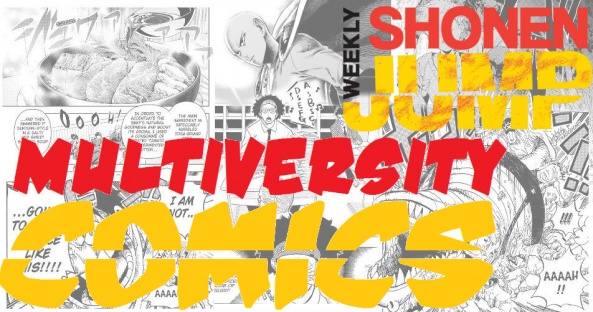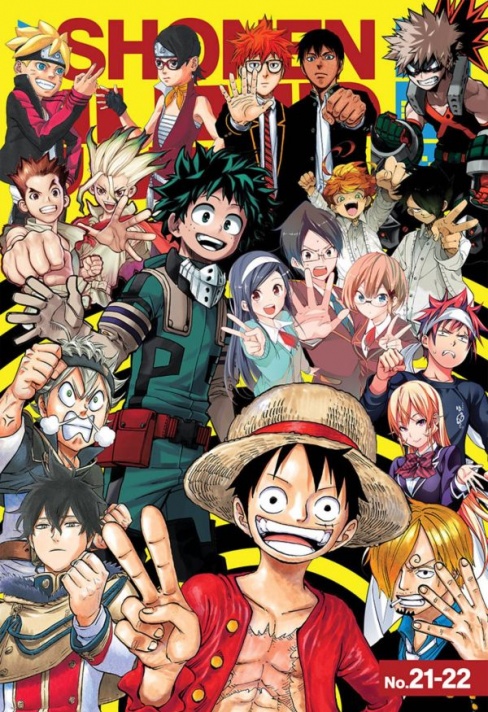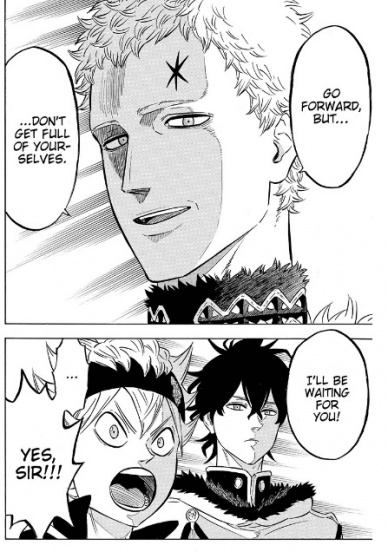
Welcome to This Week in Shonen Jump, in which a rotating duo of Multiversity staffers take a look at two stories contained in each installment of Viz Media’s Weekly Shonen Jump. For the uninitiated, Weekly Shonen Jump is an anthology that delivers more than 200 pages of manga of all varieties. We hope that you’ll join us in exploring the world of Weekly Shonen Jump each week. If you are unfamiliar, you can read sample chapters and subscribe at Viz.com.

This week, Matt and Rowan are back! If you have any thoughts on the two titles discussed this week, or thoughts on “Dr. Stone,” “One Piece,” “My Hero Academia,” “Robot X Laserbeam,” “Yu-Gi-Oh Arc V,” “We Never Learn,” or “Food Wars,” let us know in the comments!

The Promised Neverland Chapter 36
Written by Kaiu Shirai
Illustrated by Posuka Demizu
Reviewed by Matt Lune
The Promised Neverland may, in fact, be my favorite series currently in Weekly Shonen Jump. Which feels like a strange admission, because The Promised Neverland is the most unlike any of the other Shonen manga in the anthology, and unlike any Shonen manga I’ve ever read. Nevertheless, this chapter is a pretty perfect example of why this series has me so captivated. Picking up the already swift pace set by the previous few chapters – this being the fifth chapter of the arc entitled, appropriately, ‘Action’ – the twists and turns keep coming as the truth about what’s actually being going on continues to unravel.
The greatest gift of this series is coming dangerously close to becoming a curse, as the bluffs become double bluffs and what we think is going on is almost always not what first appears, and this is happening so frequently during this arc that, not dissimilar to movies like The Usual Suspects, it feels thrilling and clever at the time, but when you go back and try and piece it all together it doesn’t quite stand up to the scrutiny. The people you thought didn’t know, do, but their enemies know too except they don’t because there’s a plan behind the plan, and so on into infinity.
We’re not at that breaking point yet, however, and The Promised Neverland is not shy about showing its work. Every revelation in the plot, every moment of clarity a character experiences, brings with it a few small flashback panels to moments earlier in the run that either foreshadow this twist or present themselves in an entirely new light given this new information. The children are escaping, their plan is more thorough and complex than previously hinted at, and as such, contrary to all expectations, they remain one or two steps ahead of Mom throughout the chapter.
The wonderfully morbid appeal to this series is how utterly hopeless the children’s situation seems to be, only getting worse with every new morsel of information we learn about the world outside of the nursery walls. This chapter, however, presents perhaps the first true glimmer of hope we’ve seen, and what happens at the end of the chapter teases a whole new status quo moving forward. Certainly it doesn’t feel that way looking at the opening splash page, as we get a rare, gloriously disturbing look at the monstrous overlords that are harvesting the children’s brains for what we can only assume is food. The artwork throughout the series often leans into the cutesy; emphasising the wide, innocent eyes of the kids; the warm, friendly face of Mom (despite what we know about her true intentions); and the idealistic nursery surroundings that seem designed to draw on the sepia-tone filtered memories of childhood. In fantastically terrifying contrast, when we get to see the monsters in all their veiny, absurdly alien proportions and vicious, exaggerated claws, it feels even more extreme because of that constant contrast.
The Promised Neverland is always unnervingly dark, and the very concept is ridiculously bleak, yet this chapter feels like the start of a turn back towards the sort of adventurous fight against an almost insurmountable foe that fans of Shonen manga are used to. That, or it’s all a triple bluff and I’ll be eating my words by next week.
Continued belowFinal verdict: 8.5 – An action packed chapter with a surprisingly welcome sense of optimism.

Black Clover Chapter 107
Written and Illustrated by Yuki Tabata
Reviewed by Rowan Grover
Black Clover’s latest chapter serves as a pretty good jumping on point as Yuki Tabata sets up the next story arc – the formation of the Royal Knights to take out the Eye of the Midnight Sun. However, it’s not a particularly eventful one. We get the introduction of the lacklustre and fraudulent Augustus, King of the Clover kingdom, but the whole chapter is essentially just him addressing the kingdom. For newcomers, we do get a good sense of character from mainstays like Asta and Yuno. When Asta asks a question that directly attacks the king’s ideals, he asks it genuinely and innocently. From this we can draw that Asta’s not a typical Shonen protagonist – he is smart, but still naïve.
It’s interesting seeing the passive aggressive quarrel between the King, and Julius the Wizard King. The former is a pompous and flawed figure that constantly vies for the favour of the public to little success. He’s constantly trying to steal the approval of the more even mannered Julius, who is cleverly written to level the King’s ambition and become a more sympathetic figure. When Julius tals the King out of executing Asta and Yuno, we see a lot of this evident in his overly smiley character, especially as he convinces the King that keeping them alive will eventually work in his favour.
I do like the Tabata’s use of ongoing plot threads, especially as we’re shown Asta still struggling to come to grips with his latent abilities. It’s a typical Shonen trait to have this kind of staggered power growth throughout a series, but I’m a real sucker for it – I love bouncing around potential scenarios and theories of what the characters could become in my head. Tabata manages to just that by drip feeding us information about Asta’s power and the formation of the Royal Knights, especially as Julius reveals a somewhat darker side as he encourages our protagonists to compete for the group, but that they may not be strong enough just yet.
Tabata plays up the comedic aspect of his art a lot more in this chapter, which works well on King Augustus’ portrayal. The second to fourth page sequence is a great example of Tabata’s humour – we have Augustus introduced as a generic, regal looking character who rapidly turns into a short-tempered man yelling ‘GLORIFY ME MORE, WOULD YOU?!!!’. We get a lot of these over-the-top portrayals of the King and other characters, which can feel a little stale at times. This is blatantly evident with Asta’s weird little asides with scrunched up angry faces after the King says something stupid.
However, Tabata’s dynamic expressions work at the right moments, too. The King looks sufficiently sly and cunning as he announces the formation of the Royal Knights and the finding of the Eye of the Midnight Sun. Similarly, when Asta looks up to ask Augustus whether or not he should be choosing the appointed knights, it’s a quiet moment with literal wide-eyed innocence amidst an otherwise noisy scene. Tabata really nails the show-don’t-tell theme of the artwork here, managing to effectively convey tone and mood through the art without convoluting the narrative with it. When he does, fortunately it works to comedy relief, especially as Yuno tells Asta ‘READ THE MOOD, WOULD YOU?’
Tabata caps off the chapter brilliantly with a jarring, exhilarating tone shift to fast paced action. We had smaller, subtler examples of this throughout the book, mainly with King Augustus’ mood swings, but it’s done best on the transition from the second last to last page. We’re thrown just as brusquely and without warning as Asta and Yuno are into a ‘bloodbath’, with the rival team The Crimson Lion Kings being scolded by their leader. It’s both humorous and head-scratching enough to make you want to come back next week, which feels unique in execution.
Black Clover manages to stand out as a manga both acknowledging it’s Shonen predecessors and coming up with new ideas, and chapter 107 is a great point to jump on with. It may be a little slow, and recycles some shallow character ideals, but sets up continued development of long running plot points and new sides to characters we haven’t seen before. This is a story arc to keep an eye on.
Final Verdict: 7.0 – A slow yet intriguing introduction to a new story arc, Black Clover remains to be one of the stronger Shonen Jump weeklies.






